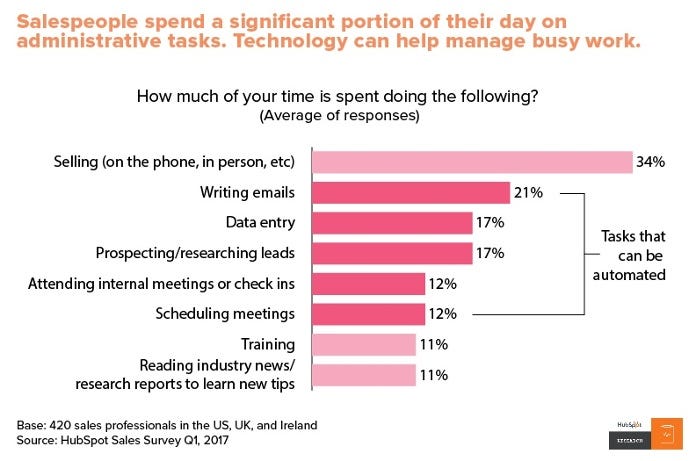

Over the last few years sales enablement as a business buzzword has taken off. We take a deeper dive into the definition, whether it's here to stay and what it means for your business.
Building product companies with sales enablement in place have benefited from higher win rates, larger deal sizes and faster sales cycles. In an environment where project delays can be inevitable, organisations with sales enablement in place have a much more predictable sales cycle.
What Is Sales Enablement?
Sales enablement is providing salespeople with the information, technology and content to help them sell more efficiently and effectively.
Research group IDC defines it as:
“The delivery of the right information, to the right person at the right time in the right format, and in the right place to assist in moving a specific sales opportunity forward.”
It is a function within a business, and over the last few years companies have even started advertising for sales enablement as a role within an organisation.

Research suggests that only 1/3 of a salespersons time is spent selling. The rest is spent on searching for or creating content and routine tasks such as admin, updating the CRM or reporting.
What Sales Enablement Is Not
Sales enablement is not just simply buying new selling technology or productivity tools. It requires sales and marketing alignment, robust sales processes, communication and internal support.
The responsibilities of sales enablement are as follows:
- Equip your sales team with relevant content for customers at every stage of the buyers’ journey
- Standardise processes and best practices
- Give your sales team real-time visibility into when customers are engaging with your content.
- Deliver data and analytics into what’s working and what isn’t
- Use cutting edge technology, A.I. and automation to free up a salesperson’s time
Ultimately it drives revenue by directly impacting sales teams’ ability to engage with more potential customers and close more deals.
How Others Define Sales Enablement
Taking a look at the study by Demand Metric, participants chose from a range of phrases to define sales enablement. Here are the top choices:

What The Experts Think
When we take a look at Google trends ‘sales enablement’ as a term has only taken off over the last few years. It looks like it is here to stay, leading groups of analysts have taken notice including Sirius, Forrester, Gartner and many more.

Todd Berkowitz, managing vice president at Gartner predicted at the beginning of 2017 the rise of sales enablement. Noting the development of sales enablement platforms, investor interest and uptake in sales enablement technology within organisations. Describing that when it’s used appropriately with data it can create a virtuous feedback loop.
Heather Cole, Sirius Decisions’ research director shared at the Sales Enablement Society Conference in Dallas, 26 percent of sales enablement functions report to CEOs. In addition, high performing companies are 96 percent more likely to have the function at that level.
Mary Shea, principal analyst at Forrester Research and Justin Shriber vice president of marketing at LinkedIn discuss sales enablement in a Youtube interview. Stating that it will ‘drop real dollars to the bottom line’ and salespeople will have to be a lot more collaborative with marketers.
Sales Enablement Techniques To Boost Your Quota
Close the loop between sales and marketing
This requires a joint effort, weekly meetings, an agreement on what a marketing qualified lead looks like, shared content and shared goals. According to research group Aberdeen, aligning sales and marketing leads to 38% higher sales win rates.
Define the sales process and create content around it
Sales enablement content generally falls into one of two categories. First, content that sales provide to the buyer. Second, what can be consumed internally to improve the effectiveness of the team, best practices, research and tools.
Ensure sales reps know how to use the resources provided to them
High-performing sales organisations are twice as likely to provide ongoing training as low-performing ones. When you’re providing sales enablement technology, ensure your sales team understand the benefits and also how to use them. Failure to do so will result in low adoption, wasted resources and stunted growth.
Resources should be easy to find and easy to apply
Whether it be a presentation, contract or case study. Sales enablement is owned by both sales and marketing. Ensure there is a centralised location such as a CRM for common resources. This may include content, conversation guides and sales training.
Use data and analytics to optimise your sales process
Mapping each stage of your sales process will allow you to identify where there might be drop-offs in it. You’ll also be able to identify top performing reps, what they’re doing and how it can be replicated.
Measure
Use sales enablement tools to calculate metrics such as average deal size, sales cycle length and quality of reps’ efforts (e.g. calls made, meetings booked, deals created, deals lost, deals won). Having this insight will enable you to flag issues before they become a problem.
Conclusion
Companies using sales enablement are benefitting from increased quota attainment and higher win rates. With a shift in what specifiers want from a building product company, providing the right information to buyers at the right time in the right format has now become more important than ever.
With interest from businesses, analysts, experts and better access to data than ever before sales enablement has become accessible to companies both large and small.
|
Read More |
About Insynth
As the only HubSpot certified agency to major on construction marketing, we bring together construction marketing strategy, digital strategy, website design, SEO, content marketing, email marketing, sales automation, marketing automation and HubSpot CRM implementation to produce successful campaigns and great results for our clients.
Book Your Free Consultation Today

